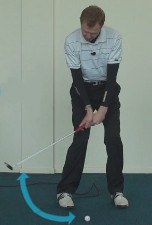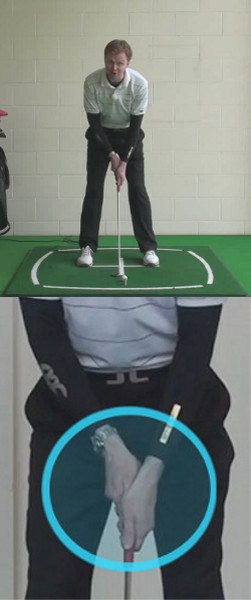
The most memorable moments of Ben Crenshaw's two Masters victories happened on the greens. That's only fitting, since Crenshaw is regarded as one of golf's all-time greatest putters.
Crenshaw created the first of these indelible images in 1984, when he holed a long, sweeping birdie putt on Augusta National's 10th green in the final round. The second came on the 18th hole in 1995, with Crenshaw breaking down after the clinching putt just a week removed from the death of his mentor, Harvey Penick.
Naturally, “Gentle Ben” credits Penick for helping him develop the most envied stroke in golf -- and Penick's guidance had nothing to do with technique.
An 11-year-old Crenshaw was on the practice green at Austin Country Club with a dozen or so balls, putting each one from the same spot to the same cup, when out strolled Penick. Crenshaw picks up the story: “He said, 'That's good for just that particular putt right there.' He said, 'You'll never have that putt again the rest of your life... Go putt to other holes.'
“That's the only way you get imagination and feel.”
The directive was in line with another pearl of Penick wisdom. “He said, 'Never try to look like anyone else when you're putting,'” Crenshaw recalls. “You have to be yourself when you putt.”

Crenshaw clearly took those words to heart. His stroke is one of a kind, a long, flowing motion which rolls the ball with perfect pace, time after time. Crenshaw is especially adept from mid-range to long distance, his putts trickling toward the hole and dying just over the lip, or within tap-in length.
His prowess on the greens helped Crenshaw overcome a tendency toward wildness off the tees. After a celebrated amateur career in which he won the NCAA individual title three times, Crenshaw went on to claim 19 PGA Tour titles. He was inducted into the World Golf Hall of Fame in 2002 and continues to compete on the Champions Tour when he's not designing amazing golf courses with partner Bill Coore.
What it looks like: Crenshaw's long putts seem to flow toward the hole, usually taking the maximum break as he aims to roll the ball just far enough to reach the cup.
How Crenshaw does it: His setup and stroke, as you'd expect for a “feel” putter, are highly individualized. Crenshaw aligns his feet and shoulders left of the target, with his hands well forward of the putter head and more weight on his left side than his right. Crenshaw swings the putter back very slowly, focusing on a smooth tempo. His forward stroke mirrors this silky, unhurried pace.

How you can do it: Gentle Ben's key recommendation to amateurs: Lighten up on your grip pressure to the point where the putter feels heavy. This allows the putter to swing, pendulum like, rather than the hands and arms forcing it back and through. “It should be held as a delicate instrument,” Crenshaw says, “because you're doing delicate work.”
Other critical points include striking the ball solidly and keeping your head still throughout the stroke. That's about the extent of Crenshaw's technical advice. Otherwise, it's all about comfort and feel.
“Putting is fingers and hands and eyes, and imagination,” Crenshaw says. Pay more attention to pace than line, and try to roll long putts right up to the hole.
Above all, Crenshaw says, “Be natural.” In other words, don't get caught up in mechanics. You'll three-putt less often and sink the occasional bomb.

Ben Crenshaw Pure Rolling Putts
As a golfer, you already know that putting is perhaps the most important single element of the game. Your score for a given round is largely going to be determined by how well you roll the ball, as making a few extra putts is often the difference between a great round and a decent one. Even if you already know that to be true, it never hurts to see a great example of just how important putting is in this great game. That example comes in the form of Ben Crenshaw, a Hall of Fame player with two major titles to his credit.
Crenshaw, simply put, is one of the best golfers the game has ever seen. In addition to winning the Masters in 1984 and 1995, Crenshaw also managed to take home 17 other PGA Tour wins during his long career. Overall, Crenshaw has 29 professional wins to his credit, all coming after an impressive career at the University of Texas. While you have to have a solid all-around game to achieve those heights in golf, Ben Crenshaw has always been known for one specific thing – his putting. Many would say that Crenshaw is the best putter in the history of the game, and it is certainly hard to argue with that notion.
Of course, the greens at Augusta National are known for being some of the toughest in the world to navigate, so Crenshaw's two wins in the Masters should tell you everything you need to know about his putting. At only 5'9'', Crenshaw was never going to overpower the golf course. However, he was an accurate ball striker and a deadly putter – a combination that is always hard to beat. In addition to his incredible playing record, Crenshaw is also noted in golf history as being the captain of the U.S. Ryder Cup Team which rallied from a big deficit to defeat the European side in 1999.
In this article, we are going to take a look at what it is that made Crenshaw such a great putter, and what you can learn from those lessons. The exciting thing about learning putting from someone like Ben Crenshaw is that you should be able to directly apply many of his theories or techniques into your game right away. While you shouldn't expect to putt at the same level as Mr. Crenshaw anytime soon, you should be able to expect to take your putting performance in the right direction. Learning putting from a top pro is much more reasonable than trying to learn the golf swing from a pro who specializes in monster tee shots. For instance, if you tried to swing like John Daly, you would only wind up disappointed (and possibly injured). Take the time to learn from a legendary putter like Crenshaw, however, and you may see a few more of your own putts fall in.
All of the instruction below is written from the perspective of a right handed golfer. If you play golf left handed, please be sure to reverse the directions as needed.

It's All About Simplicity
If you are going to learn about putting from one of the best putters in the history of golf, it only makes sense to listen to what he has to say about the topic. After all, you aren't going to learn all that much from watching Crenshaw putt – it is a simple motion, with the putter swinging back and through the ball consistently time after time. So what does Crenshaw have to say about why he has been so successful on the greens? For one thing, he credits his ability to keep it simple. By making his putting stroke, and his approach to putting, as simple as possible, Crenshaw has been able to ride his putter to incredible heights.
Of course, it does make sense to keep the putting stroke simple. After all, you aren't trying to do anything crazy when putting – you are only trying to roll the ball along the ground a short distance toward the hole. Hitting full shots is far more complex than anything you will do on the greens, which is why the golf swing can get so complicated. Don't let that complexity come with you on the greens, however, as there is no reason to ignore Crenshaw's advice in this area. Keep your putting as simple as possible and you will be rewarded with improved results.
So what can you do to keep your putting stroke as simple as possible? The following points are a great place to start.
- Rock your shoulders. Your hands and wrists should not be involved in the putting stroke at all. Using too much hand action in the putting stroke is a classic amateur mistake, so work on performing the putting stroke with only your shoulders while everything else stays quiet. This is one of the best ways to keep your stroke simple as you will only have to think about one moving part – as long as your shoulders are rocking and everything else is staying still, you should be on the right track.
- Hit your putts straight. This might sound a little weird at first, but it makes a lot of sense once you think it through. One of the complex parts of putting is trying to figure out the break that the ball is going to take between the putter and the hole. Of course, there is nothing you can do about that – golf courses aren't going to flatten out their greens anytime soon. However, you can separate out the process of reading the green from the actual stroke that you make. Once you read your putt, you should aim at a spot that you think will properly account for that read. Then, from there, you are going to treat all your putts as straight putts. In other words, you are going to make the same stroke each time, rather than trying to 'steer' the ball toward the hole. Trust your stroke, repeat it time after time, and keep it as simple as you can.
- Get as close to the hole as possible. This is a piece of advice that comes directly from Mr. Crenshaw himself, and it is brilliant in its simplicity. Think about what is normally on your mind when you are putting – what is it that is running through your head? Most likely, you are thinking about a number of different things, including the technical aspects of your stroke and the read that you picked out for the putt. When you strip that away, however, you get down to the basic goal of putting – to put the ball as close to the hole as possible. You are never going to make all of your putts, so it makes sense to focus instead on getting as close as you can time after time. As long as you are always focused on rolling the ball up close to the cup, you should see more than your fair share drop in as the rounds go by.
It might not be particularly easy to keep your putting stroke simple when out on the course, but that is exactly what you need to do. Hopefully, through the use of the three tips above, you can take a big step toward keeping things simple, and your results should quickly improve as a result.

Be Yourself
Perhaps the best single piece of advice that Ben Crenshaw has to offer with regard to putting is this – you should be yourself. If you look back over the history of the game of golf, it is easy to see that there have been players with all sorts of different putting styles. Just as the case with the full swing, there is more than one way to get the job done on the greens. If you are trying to force yourself into certain positions in order to copy your favorite player, you are making a big mistake. Rather than trying to be somebody else on the greens, just be yourself and you should be happy with the outcome.
What does this mean? First, you should be standing in a way that is comfortable to you over the ball. When hitting full shots, you need to be in a position that is going to allow you to swing the club properly through the hitting area. That is not such a big concern when putting, however. Since the putting stroke is so small, and the impact with the ball is so gentle, you don't need to be particularly worried about the details of your stance. Instead, you should make sure you are comfortable, relaxed, and ready to roll the ball toward the cup. Experiment with a variety of stances during your putting practice sessions and pick out the one that promotes a comfortable feeling above all else.
Another area of individuality when it comes to putting is within the grip. This is where putting breaks free from the full swing in a significant way. When making full swings, you need to be careful to follow a few grip fundamentals that will help you achieve success. On the greens, however, you are free to hold on to the putter in a number of different ways, as long as you are complying with the rules of golf. If you take a moment to watch some golf on TV, you will notice that the players of the PGA Tour hold their putters in any number of different ways. Just as was the case with the stance, take some time to try out different grips and use the one that seems to lead to the best results. There are no right or wrong answers on this point, so it is going to be up to you to select a grip that you can trust. Instead of copying the grip of a great putter like Ben Crenshaw, forge your own path and place your hands on the putter in a way that works for you.
One last area of personal preference when it comes to putting can be found in the speed that you use to attack the hole. Some golfers like to 'die' the ball next to the hole, meaning their putts are running out of speed just as they reach the cup. On the other hand, some players like to putt aggressively, forcing the action by sending the ball toward the hole with plenty of speed to spare. These players are able to take some of the break out of their putts through the use of extra speed, but they have to deal with the possibility of facing a long comeback putt if the first one should miss.
Again, don't putt a certain way because you see another player doing so. Settle on your speed plan by practicing your own stroke and going with the option that feels right to you. If you are naturally aggressive, putting with plenty of speed is probably the right choice. Or, if you are a conservative, patient person, slowing dying the ball at the cup will make the most sense.

Stick with Your Stroke
You want to have a close, trusting relationship with your putting stroke – but that isn't going to happen if you are constantly fiddling with the way you putt. Rather than changing your putting stroke each time you run into a rough patch on the greens, think about looking to other methods to improve your performance. Ben Crenshaw is a proponent of keeping your stroke the same over time, and it is easy to understand why when you look at his performance.
So what should you do, other than changing your putting stroke, when you are struggling on the greens? The following points offer up a few ideas.
- Spend some time practicing. This might seem like an obvious point, but you may be able to shake yourself out of a putting slump simply by spending some time on the practice green. If you are struggling with your stroke at the moment, leave the rest of your clubs at home the next time you head out to practice. Instead, take only your putter and a handful of golf balls. Don't think about anything technical during this kind of practice session – just work on knocking the ball into the hole as often as possible.
- Take some time off. If practicing your putting only seems to make the problem worse, you may actually need to go in the opposite direction. Take a few days away from the course, if possible, and do something else with your time. Poor putting has a way of getting in your head, so going back out day after day may only allow the problem to get worse and worse. When you come back from your break, you may have forgotten about your struggles and you will be able to refocus on performing at a high level.
- Change your speed plan. As mentioned above, golfers tend to fall into one of two categories when it comes to the speed they use on the greens – either they putt aggressively, or they putt with just enough speed to reach the hole. If you are firmly in one of these camps, try switching to the other side just to mix things up. By adding or subtracting speed as compared to your normal approach, you will give your mind something to think about other than the outcome of your putts. You can always go back to your more natural putting style, but this brief change of pace should help you get on track once again.
- Play more break. It is common for amateur golfers to start missing most of their putts when they don't play enough break. Should you find yourself stuck in a deep putting slump, try playing more break than you think you need for all of your putts. This might be hard to do at first, but commit yourself to the plan. Aim well outside of the hole and use every bit of break you can find to bring the ball back to the cup. By playing so much break, the ball will always be on the high side – and it will always have a chance to fall in.
Just like that, we have been able to list out four options for fixing your putting without even having to touch your mechanics. During your next putting slump, try using the fixes above rather than giving up on the technique you have built in your stroke. If you can manage to keep your stroke consistent as the years go by, you will get better and better performance from it as the experience adds up.

Don't Be Anxious
The last putting tip that we are going to look at from Ben Crenshaw is one that all golfers need to be reminded of from time to time. Crenshaw himself says that most of his misses stem from looking up too early to see where the ball was going to go. Of course, you probably already know that this is a mistake – but most golfers are still guilty of this sin from time to time. To take a big step forward in your performance on the greens, work hard on your ability to stay down through your putts. The temptation to look up early in strong, but remind yourself that the reward for staying down is going to be more made putts – and a lower score at the end of the day.
To help improve your ability to stay down on your putts, you might find it useful to use the following drill. If you add this drill to your regular practice putting sessions, you should find that the temptation to look up early on your putts slowly fades away.
- Take five golf balls and place them down in a group on the practice putting green. You should be positioned in a spot that is roughly five feet away from a hole that you can use for this drill. Ideally, the ground between your group of five balls and the cup will be relatively flat. It is okay to use a breaking putt for this drill, but it will make it harder to complete successfully.
- Before you hit the first putt, step back and read the putt. If it is going to break to the left or right, adjust for that break as you step up to take your stance. Once you have settled into your address position, you will be ready to get going.
- With the putter head behind the ball, take one last look up at the cup and then look back to the ball. Next, you are going to close your eyes. Once your eyes are closed, go ahead and hit the putt. Since your eyes are closed as you make your stroke, there really won't be any temptation to look up early – because you wouldn't be able to see the ball anyway. After the ball leaves the putter, listen for it to fall into the cup. Once you hear it fall in, or once it has missed, you can open your eyes and set up for the next putt.
- Repeat this process for all five balls and review how you have done at the end of the five putts. If you have time, you can continue this drill until you are able to make all five putts within a given set.
Putting with your eyes closed is a great way to take away the temptation to look up early. This is such an effective technique that some golfers have even taken to hitting their short putts with their eyes closed while on the course. You don't necessarily have to go that far, but this drill is one that can be a huge help in the battle against looking up early.
Without a doubt, Ben Crenshaw is one of the best putters in the history of the golf. There is a lot that the average golfer can learn from the lessons Crenshaw has to offer in this area of golf, so be sure to take his tips to heart. Good luck!






